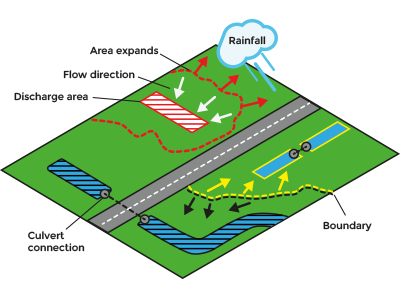Watershed Module overview: Difference between revisions
Jump to navigation
Jump to search
No edit summary |
|||
| Line 1: | Line 1: | ||
{{Template:Watershed Module buttons}} | {{Template:Watershed Module buttons}}__NOTOC__ | ||
==Overview== | ==Overview== | ||
[[File:Watershed_introduction.png|right]] | [[File:Watershed_introduction.png|right]] | ||
Revision as of 15:29, 25 May 2020
Overview
The watershed module calculates discharge areas for rainfall based on a digital terrain model or a calculated flow direction result of a Water Overlay. The watersheds can provide an indication into which water way rainfall ends up. Users can assign and group water ways as initial input using discharge areas.
Input
- Water terrains
- Discharge areas (Advised)
- Either:
- Water Overlay's surface flow direction result type;
- Digital terrain model (DTM).
- Culverts (Optional)
Options
- Discharge remaining water: Create additional discharge areas for water bodies that are not connected by culverts to discharge areas.
- Fill distance: unmatched cells are assigned to nearest found discharge area when within the provided distance.
- Discharge method:
- Height minima: Restricted to height map input data
- Water terrains: Restricted to directional data. Each water body is a separate discharge area.
- Specific areas: Restricted to directional data. Water body cells that intersect with a specified discharge area are assigned to that area. Water bodies that are connected by culverts to discharge area water bodies are assigned to that discharge area as well. Depending on the option "Discharge remaining water", the remaining water bodies are stored as a separate discharge area.





